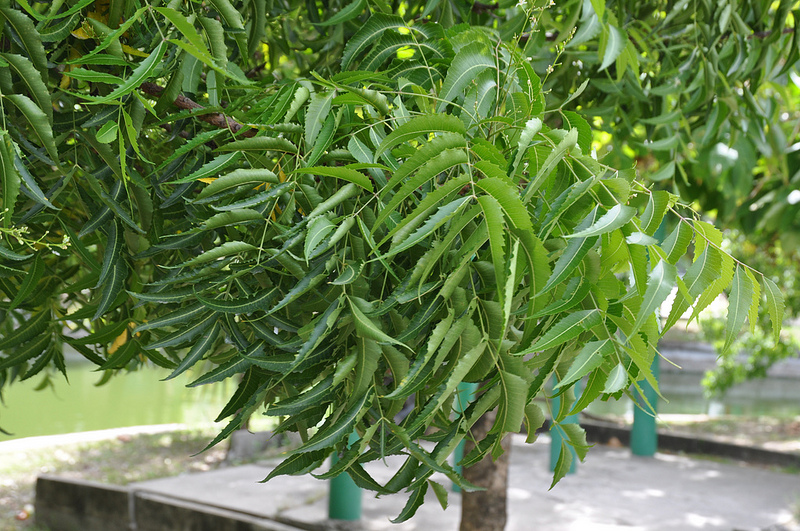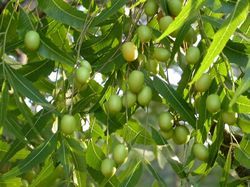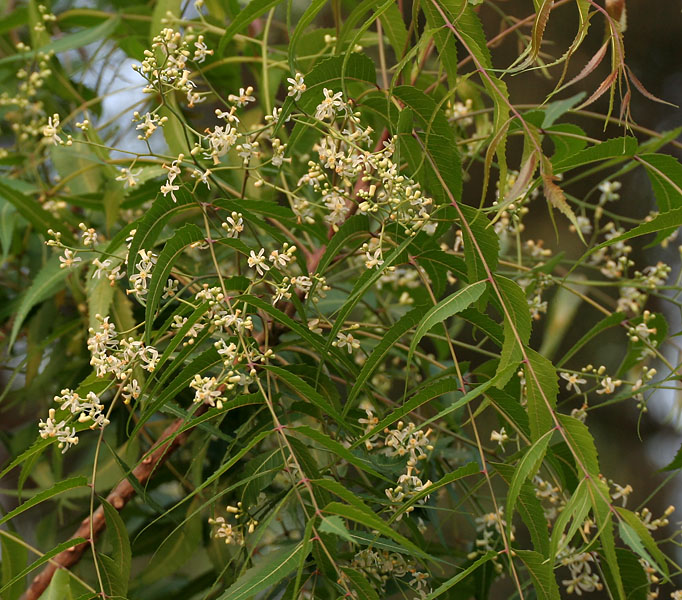Azadirachta indica A.Juss
| Botanical Name | Azadirachta indica A.Juss |
| Order: | Sapindales |
| Family: | Meliaceae |
| Genus: | Azadirachta |
| Species: | A. indica |
| Common Names: | Neem, Indian lilac; Margosa tree; Nim, French: Margousier; Nim |
Plant Synonyms
Malia azadirachta L., Melia indica (A. Juss.) Brandis, Azadirachta indica var. minor Valeton, Azadirachta indica var. siamensis Valeton, Azadirachta indica subsp. vartakii Kothari, Londhe & N.P.Sing
Plant Local Names
Burkina faso: Moore -nim, Dioula – nimyiri Fula Fulfulde – Tirotiya; ; Goodji
Cote d’ Ivoire: Akye – Dje ndedzakole, Ando tchitchende
Gambia: Twi –Dua gyana, Ewe – liiiti, Hausa – Dongo yaro
Mali: Bambara – Mali yirini, Senouto – grimtique, Dyula – Goo-gay#
Niger: Hausa – Dogon yaro, Kanuri – Ganya nim. Yoruba – Dongoyaro
Senegal: Manding Mandinka – tubabo toboro, Soce- tubabo.
Togo: Ewe- sabuleti, Mina – kiniti, Adja – sablagbe
Plant Habitat
Tropical evergreen tree; originates from India and Burma grows in Southern Asia and West Africa; found commonly in the coastal and Northern Savanna areas of Ghana but found growing or cultivated both in the northern parts of Nigeria. Now cultivated in the Caribbean and much of Central America (Trewari, 1992; GHP, 1992). Plant readily grows even without irrigation, in arid and semi and regions and in poor sandy or stony soil where gardening or cultivation is normally impossible.
Plant Material of Interest
Leaf, Sterm bark and seed
Plant Description
Indica is a tree that can reach 25 m high, straight – boiled, with striped and fissured bark; alternate paripinnate leaves with about 5-8 pairs of asymmetrical leaflets at the base, long acuminate tip; ovate- lanceolate, margin coarsely serrated; inflorescene in axillary panicles; many flowered, flowers white, numerous and pedicellate pedicels about 1.5 min long sepals white, paeals oblanceolate, to 6 mm long, anthers within lobe apex; fruit ellipsoid, fruit ovoid, one-seeded, glabrous yellow when ripe. The plant can live up to about 200 years (Trewarri, 1992).
Plant Used Parts
Plant Uses
Indica is used for the treatment of malaria, cough, nausea, vomiting, fever, jaundice, gonorrhoea, intestinal worm infestation, skin disorders, boils, ulcers, eczema and leprosy in indigenous system of medicine.
Plant Therapeutic Action
Antiemetic antifeedant, (insecticide), antifungal, antiiinflammatory, antimalarial, antiseptic, (in medicated soaps) antipuritic; antipyretic, antiviral (systemically), ankiolytic, depurative, emmenagogue, galactogogue, hypoglycaemic, immune stimulant, vermifuge (GHP, 1992).
Plant Precaution for Use
Caution should be taken in the administration of the aqueous extract in liver and renal disease. Neem extracts should be taken for prolonged periods at high doses; limonoid show a very low toxicity, especially in oral administration. Toxic effects have been observed in animals grazing on neem leafs
Plant Adverse Effect
None reported and none expected if taken in therapeutic doses
Plant Contraindication
Known renal and/ or hepatic disease, hypoglycaemia, elderly children; pregnancy and lacation.
Plant Dosage Forms
Decoction; frincture; liguid extract
Secoction; 30 g dried leaves in 900 ml water; simmer until reduced to 600 ml; 1 teacup three times daily; tincture- 1:5 in 45% alcohol, 5 ml three times daily
Liquid extract 1:2 in 45% alcohol, 2.5 ml three times daily
Plant Dosage
Plant Storage
Store in a cool dry place
Plant Chromatographic Fingerprint
Analytical TLC on silica gel G60 F254, 0.25 mm layer in peroluem ether (40-60? Cychloroform [2:8], detection in day light, after spraying with anisaldehyde (0.5 ml) mixed with 10 ml glacial acetic, 85 ml ethanol and 5 ml concentrated surlphuric acid and heated to 100-110C? for 5-10 min. presence of three characteristic spots with R,s of 0.45 (dark grey), 0.33 (pink) and 0.29 (green).
Plant Constituents
Alkaloids tannins coumarin, sigmasterol, favoniods/polyphenols. Saponins and suger, Vitamin C. triterpenses/maliaceous/limonoid componds azadirachtin, nimbolide, grdunin, salanin, other maliacins; diterpenses; carotenoids, reducing sugars and fixed oil present
Plant Pictures
Plant References
African Pharmacopoeia Vol. 1 (1985). Ed. 1, Published by the Organisation of Africa Unity’s Scientific Technical Esearch Commission Lagos Nigeria Pp 30-31.
Aladesanmi, A.J., Awe, S.O., Adesanya, S.A., Bray, D.H. (1988). Antimalarial activity of some Nigerian medicinal plants in: Adesina, S.K (Ed) Drug production from natural products. Proceedings of the 7th International Symposium of DRPU. Medex Publications Lagos, Nigeria.
Ansari, K.U., Kasturi, N., Tewarson, S.L., Singh, S., Pandey, R.C. (1997). An experimental and potential of Azasirachta indica (Neem) extract. Indian Journal of Clinical Pharmacology and therapeutics. 8:82-84.
Bandyopadhyay, U., Biswas, K., Chatterjee, R. Bandyopadhyay, D. et al., (2002).gastroprotective effect of Neem (Azadirachta indica) bark extract: possible involvement of K*/K*K+-ATPase inhibition and scavenging of hydroxyl radical. Life science 71:2845-2865.
Bhanwra, S., Singh, J., Khosla, P. (2000). Idian effect of Azadirachta indica (Neem) leaf aqueous extract on paracetamol-induced liver damage in rats. Journal of Physiology and pharmacology 44(1):64-68.
Chattopadhyay, R.R., (1998). Possible biochemical mode of anti-inflammatory action of Azadiracta indica A. Just in rats. Indian journal experimental biology 36:418-420.
Chattophadhyay, R.R. (1996). Possible mechanism of antihyperglycaemic effect of Azadiracta indica leaf extract. Part 1v. General Pharmacology 27:431-434.
Chattopadhyay, R.R., (1997). Effect of Azadiracta indica hydroalcoholic leaf extract on the cardiovascular system. General Pharmacology 28:449-451.



